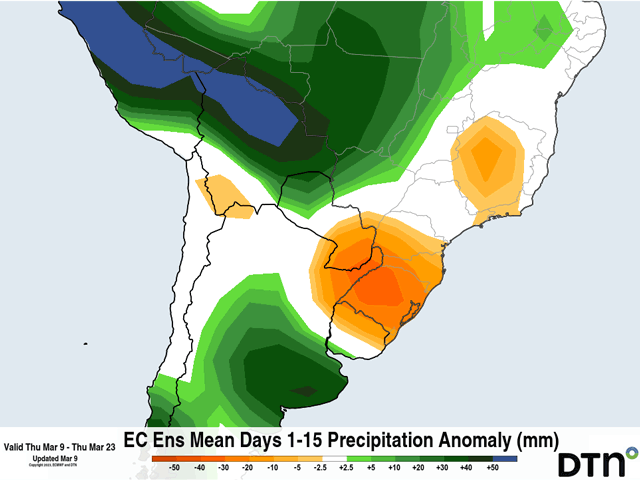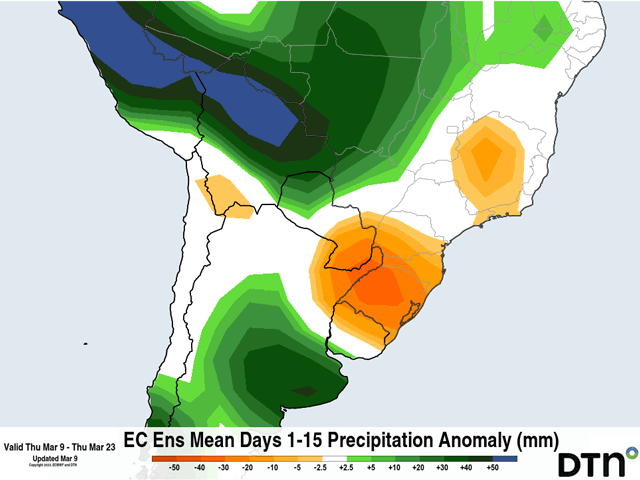South America Calling
What Satellite Imagery Shows Us About Brazil's Crop Progress
Brazil is in a busy time of year where three crop seasons overlap. Full-season crops in the far south are maturing while first-season soybeans should be harvested and second-season (safrinha) corn should be planted and emerging in the central parts of the country. At this time of year, it can get confusing as to how the progress is going, and difficult to discern what is truly going on in the country with competing information.
One way to check in on progress is to look at satellites. By using data from above, we can see where some trouble spots or good conditions may be, where areas are falling behind or pressing ahead, or even if everything seems to be going to plan.
That is a little more difficult to do in Brazil in the midst of its wet season, when so much of the country is regularly covered by clouds, but we can still make some observations in the breaks.
P[L1] D[0x0] M[300x250] OOP[F] ADUNIT[] T[]
Perhaps the best way to do so is to look at the Normalized Difference Vegetation Index (NDVI). NDVI can be a measure of crop health, but can also show shifts in crop development. By seeing an area of lower NDVI compared to normal, you can either make the case that crop conditions are poor, or that development is more advanced and the "less green" the crop would be, indicative of maturing faster than normal. Greener areas would indicate the opposite. In the attached image, I have outlined three distinct areas from the latest graphic from the USDA.
The red oval in the south is a very well-known area of trouble for the country. Much like the terrible growing conditions in Argentina, La Nina-induced heat and dryness has been detrimental to crop growth. The conditions led to delayed planting. And although this area of the country has a very long growing season, thanks to its proximity to the equator, producers have just not seen enough rainfall during much of the season to feel good about their crop. All sorts of reports have come out of the state of Rio Grande do Sul confirming what the NDVI is saying -- crop conditions are poor for a corn and soybean crop that is maturing. The widespread reds on the image indicate poor crop health instead of a shift in crop development and the region will be a drag on Brazil's crop production this season. And the soil moisture situation continues to be poor for when the wheat crop is planted in the next couple of months after the corn and soybean harvest.
The green oval in the south-central areas of Brazil include the states of Mato Grosso do Sul, Parana and Sao Paulo. This is an area that has a higher concentration of the double-cropping method of soybeans to corn. Wetness in the spring delayed some soybean planting, but heavy precipitation during the summer has been a boon to the crop. The region shows above-normal NDVI, indicative of better crop health, but also a shift in the development. With slightly cooler conditions and ample rainfall, the region is behind in its progress of soybean harvest and safrinha corn planting. Data from Deral in Parana indicate that just 17% of soybeans are harvested while 26% of corn is planted. That is behind schedule this year and indicates that the safrinha corn crop will be highly exposed to the dry season when it is forecast to occur sometime in April -- early this year due to the effects of La Nina. La Nina also has the effect of an increased risk of frosts in June and July. Concern should be concentrated in this area of the country.
Farther north, the yellow oval indicates a lot of near-normal NDVI. The soybean crop was delayed getting out of the field during the early harvest, but despite continued rainfall, significant progress has been made. Small breaks were taken advantage of and the safrinha corn planting has caught up as well. Some of this crop will still be exposed to the dry season, especially if it comes early as forecast, but the risks are somewhat lower now that planting has caught back up to the normal pace.
Continued rains over much of the country outside of Rio Grande do Sul point toward the safrinha crop at least getting a good footing once it is planted. We will wait on the end of the rains and frost potential, however, to see if significant damage may occur.
To find more international weather conditions and your local forecast from DTN, visit https://www.dtnpf.com/….
John Baranick can be reached at john.baranick@dtn.com
(c) Copyright 2023 DTN, LLC. All rights reserved.





Comments
To comment, please Log In or Join our Community .